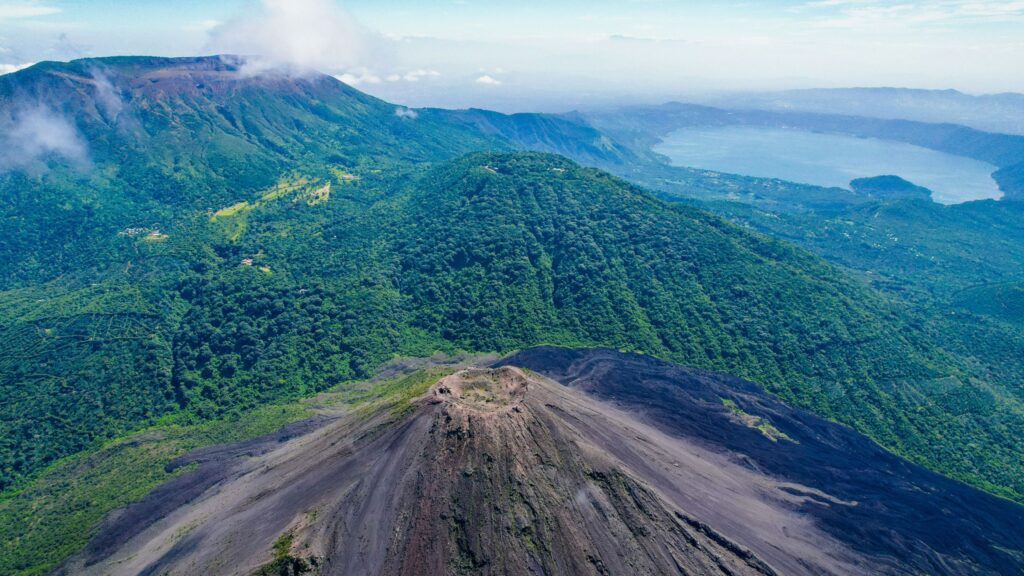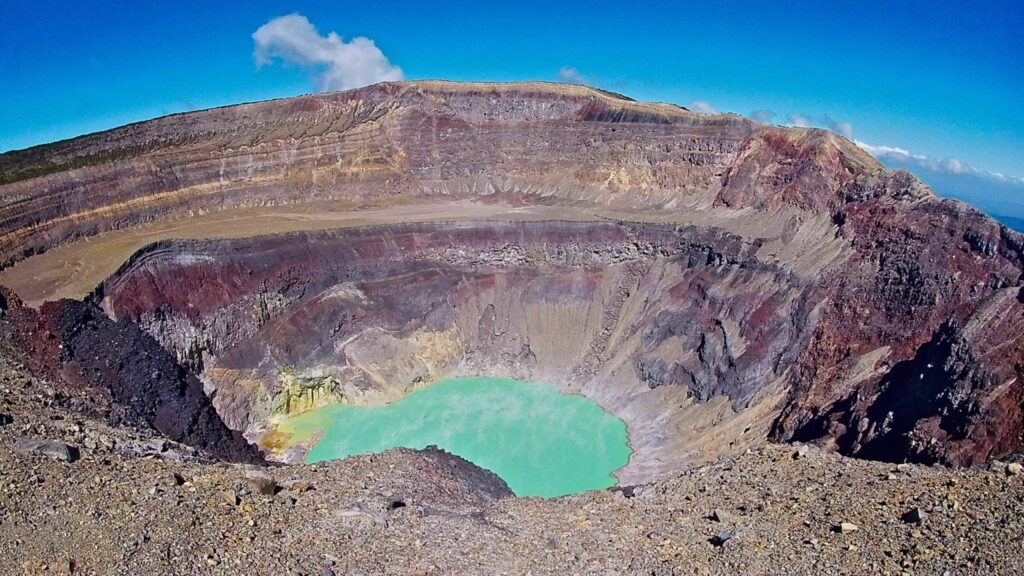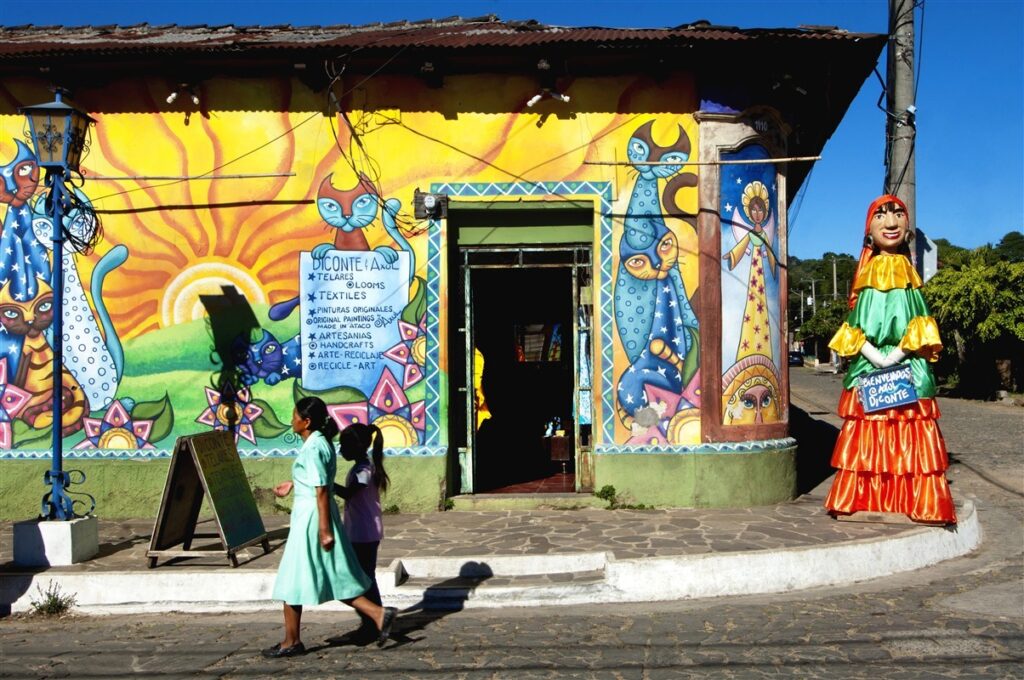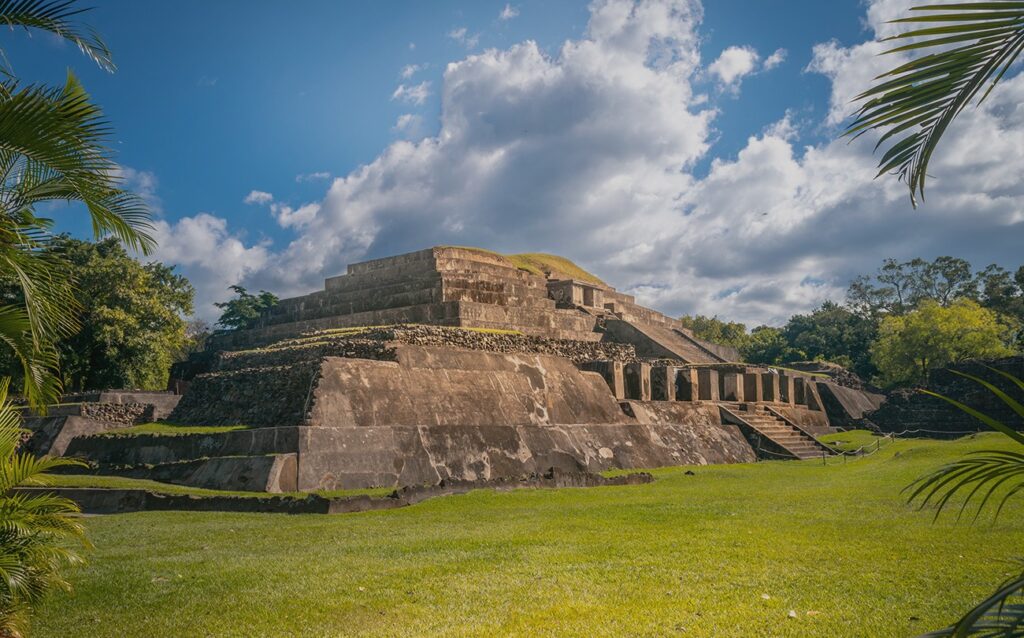El Salvador is still visited by few travelers. Those who find their way here, are in it for a treat, as traveling through El Salvador takes you to some of the most special places in Central America. Volcanoes, Mayan ruins, Indigenous villages, tropical forests, colonial cities; El Salvador has it all! Travel through this beautiful country and discover Central America’s best kept secret.
Traveling around El Salvador is a delight for travelers who love places which are off the beaten path and offer an authentic local experience. When you come to El Salvador, you will discover the most beautiful places and meet the friendly people of the country. The nature of El Salvador is beautiful. The varied landscape with tropical forests and great volcanoes make a trip to El Salvador unforgettable for the experienced hiker. Parque Nacional Montecristo is a jewel. Located at a considerable height, it provides shelter for many animal species. You can spot monkeys and maybe even a cougar. The fauna is also beautiful. Are you particularly impressed by volcanoes? Then during your El Salvador trip, visit Parque Nacional Los Vulcanes, where you can climb three different volcanoes and from where you have the most beautiful views.
During El Salvador travel you are therefore assured of a wonderful and unforgettable holiday!
1. Cerro Verde National Park (Volcanoes National Park)
Cerro Verde National Park is probably the most known national park in El Salvador and should be on your list when you’re visiting El Salvador. You’ll be trekking across black volcanic soil while accompanied by colorful birds and countless species of butterflies. Cerro Verde National Park is located on Lago de Coatepeque, tucked between three volcanoes. The park is home to many bird species such as toucans, woodpeckers, hummingbirds and also the Guardabarranco, one of the best songbirds in the world. Cerro Verde is located 37 kilometers from the city of Santa Ana in the west of El Salvador.

In the park we have three volcanoes: Cerro Verde, Santa Ana and Izalco. Izalco is a stratovolcano which is 1,910 meters high. It is a perfect cone with a perfectly round crater. Izalco is no longer active. For a long time, flames and black smoke rose continuously from the crater, giving it its nickname ‘Lighthouse of the Pacific’ as sailors would use the light of the volcano to navigate. In 1957, Izalco stopped its volcanic activity and the lighthouse was extinguished forever.
The Izalco volcano in the Cerro Verde National Park is easy to climb with good walking shoes. Make sure to bring enough water and to protect yourself against the sun. The first part of the walk is downhill until you reach the foot of Izalco. Here is the small village of Izalco, from where the difficult climb up starts. Sharp black rocks form the path to the top. Every now and then stones roll out from under your feet and you almost fall backwards, so pay attention! After an hour or so you are at the top of Izalco. In some places the smoke is still coming out of the ground. You feel the heat coming up from the inside of the earth.
The other two volcanoes can be admired from the top of where you’re standing. The Santa Ana Volcano, or Llamatepec, is right in front of you. At 2,365 meters, this is the highest volcano in El Salvador. To the left of the Santa Ana you can see the smaller and greener Cerro Verde volcano.

The sun is almost at its zenith. Fortunately, the path down is a lot easier than up. For the most part you slide down with big steps through the fine volcanic gravel. It will be a lot faster to go back down, covered in dust and with gravel in your shoes.
Lago Coatepeque is located at the foot of the Santa Ana volcano, on the edge of Cerro Verde. This clean blue crater lake is 120 meters deep and 6 kilometers wide. Many wealthy San Salvadorians have their second homes here. In Lake Coatepeque, the small Isla Teopán lies like a green mountain in the clear blue water. The island consists of a dense forest, through which you walk through various paths.
With a small motorboat you can sail from the mainland to Teopán within a few minutes. A luxury hotel is the only option to spend the night on this island. Colored birds sing to you and beautiful Monarch butterflies flutter in front of you. Long ago, the Maya used this island for spiritual rituals. Objects such as statues and a Mayan calendar have been found. What exactly they did here is not clear to archaeologists. Maybe, like you, they just enjoyed the overwhelming natural beauty.
You can also visit the nearby mountain village of Juayúa. In this village, surrounded by coffee plantations, the inhabitants take it easy. Let the day pass by while you sit in the square.
Tours to Cerro Verde have to be accompanied by a guide. You can book a tour from San Salvador to the volcanoes national park with our travel agency.
2. Montecristo National Park
The park is located in the northwest of the smallest Central American country. It is a four-hour drive from the capital San Salvador to the park. It is a difficult journey on bad roads. There is hardly any public transport to the entrance of the park.

The few who venture to this remote natural park will quickly fall in love with the orchids and butterflies of this jungle in El Salvador. In the Montecristo Trifinio National Park, El Salvador meets its neighbors Guatemala and Honduras. El Trifinio therefore also means: ‘point of three endings’. The park is the largest protected area in the country and also the most humid part of El Salvador.
From the entrance of the park you leave for a heavy trek to El Trifinio: the highest point of the Montecristo park at 2,418 meters height. It is a seven-kilometer trek through a steaming misty jungle with enormous roots of trees forming obstacles.
After three – four hours of walking you reach the top, from where you can look down on the other side of the mountain where you’ll see Honduras right in front of you and on the left you can see Guatemala, covered by thick patches of fog. You’ll be on the lookout for ground-dwelling animals, anteaters, wild boars, and agoutis, a type of large rodent found throughout Central America.
Going back down you’ll pass huge oaks of up to thirty meters high whose leaves form a natural roof blocking all sunlight. Colorful orchids and ferns up to eight meters tall shoot up from the swampy ground. During your walk you’ll hear spider monkeys shouting loudly and will observe colored toucan birds and small hummingbirds nearby.
When you’re back at the entrance, you can visit ‘The garden of 100 years’ full with blooming orchids and ferns. We can find 74 different orchid species here as well as an abundance of butterflies, insects and birds (87 species). This is a must stop and a wonderful, romantic setting which you’ll definitely fall in love with.
The park has to be visited with a guide and we recommend staying for the night and camp. If you’re looking to book a tour with camping at Montecristo National Park, our travel company can help you out.
3. Ruta De Las Flores
The Ruta de las Flores is one of the most popular routes in El Salvador and with good reason. This 35-kilometer road winds through the coffee plantations of El Salvador and is nicknamed ‘’Ruta de las Flores’, because of the many flowers that bloom in the region. The road will bring you to small villages such as Juayúa and Apaneca.

The route starts at Juayúa, a small mountain nestled between coffee plantations and volcanoes and one of the most relaxed villages in El Salvador. You’ll be amazed by the walls of houses which are decorated with beautiful paintings of flowers and portraits. The central square is the heart of the village. On the west side of Parque Central you will find the Templo Del Señor de Juayua. This white church is famous for the black Christ above the altar. Many pilgrims come to this church to pay their respects.
If you like coffee then Juayúa is the right place for you. Most of the income of this village comes from the coffee plantations. Eleven percent of all coffee exports from El Salvador come from Juayúa. Within an hour’s walk from Juayúa you will find several waterfalls, fed by the Río Santa Lucía. The waterfalls plunge down the steep rocks from a great height. At the bottom there is a lake, surrounded by flowers, where you can cool off after the walk,
Less than five kilometers from Juayúa is the village of Apaneca on the Ruta de las Flores. With an altitude of 1,455 meters, Apaneca is the highest village in El Salvador. About 9,000 people live in the peaceful town. Apaneca is the base for beautiful hikes to various volcano peaks of inactive volcanoes. Within a short time you can walk from Apaneca to the crater lakes Laguna de las Ninfas and Laguna Verde. These clear blue lakes are surrounded by green forests.
In the town itself there is a 400 year old church: San Andrés Apóstol. This symmetrical white church forms the center of Apaneca. You can buy coffee beans on the square while birds sing happily. You can spend the night at Finca Santa Leticia, a coffee plantation. During a walk on the plantation you come across three large round stones. When you get closer you see that they represent fat men.
These thick stone figures can be found in various places where the Maya once lived. Experts still think that the 2000-year-old stones were not made by the Mayas. It is not clear who is responsible for the round-belly figures.
Every weekend in Juayúa the feria gastronómica is held in the square. This food festival starts at half past ten in the morning. The locals serve delicious food at the tables that adorn the central park. In the village of San Jose la Majada, a village near Juayua, you will find the coffee museum. A guide will show you around and tell you everything you want to know about coffee.
4. Santa Ana and Tazumal
Santa Ana
Santa Ana is located in western El Salvador, 64 kilometers from San Salvador, and has about 300,000 inhabitants. Nearby Santa you can visit the Mayan ruins and tombs of Tazumal and let the legends of the Mayan gods come to life. Santa Ana is also known as ‘the city of heroes’, because of a revolt at the end of the nineteenth century against the then president and dictator Carlos Ezeta.

Santa Ana is a busy city, but less polluted than the capital. There are wide streets and in the distance you can see the green hills that surround the city. Houses are no higher than two stories and often colored in pastel shades. Parque Libertad forms the center of Santa Ana. The large Catedral de Santa Ana is also located on this square. The construction of this neo-gothic church started in 1909 and lasted fifty years.The front of the white church is decorated with small details. Inside, the architecture is sober with gray-pink checkered arches.
When you leave the cathedral, you will see the Teatro de Santa Ana on your right. This light green theater was built with tax money on coffee exports. At the end of the nineteenth century, coffee was the number one export product in El Salvador. Inside the Renaissance building you will find marble stairs and stained glass windows. The theater is still in use for concerts.
Tazumal
The ruins of Tazumal are located thirteen kilometers from Santa Ana. These are the most famous Mayan ruins in El Salvador. In Mayan language, Tazumal means ‘pyramid where victims are burned’. The complex contains the largest pyramid in El Salvador and are located near Chalchuapa. The ruin complex is small, especially compared to the Mayan ruins of neighboring countries Guatemala and Honduras. Parts of the ruins lie beneath the existing village and have yet to be excavated.

The 23-meter pyramid has twelve large steps and immediately catches the eye. This is the largest pyramid in El Salvador. The building is half covered by moss and grass. Under the pyramid we can find tombs. Climbing on the top you’ll see a group of locals excavating just south of the temple. A little further on you will see houses from the village of Chalchuapa. Behind you is the colorful cemetery that is still used.
In the museum of Tazumal you can see the pottery statues, jade jewelry and large pots that were found underground. These objects show that Tazumal traded with distant destinations in Panama and Mexico. During excavations, the statue of the god Xipe-Totec from Mexico was also found. Xipe-Totec was an important Aztec god who was feared by the people. According to legend, priests sacrificed slaves to this god. They cut the skin off the slaves and wore it during their rituals.
When you are in Santa Ana, you can also visit Lago de Güija, located 30 kilometers from Santa Ana. El Salvador shares this lake with neighboring Guatemala. Along the lake you will find several small villages and small archaeological sites where, for example, petroglyphs can be seen.
5. San Salvador
San Salvador was founded by the Spaniards in 1525. Three years later, the city was moved thirty kilometers and the old San Salvador is now called Suchitoto.

Present-day San Salvador is located in the center of the country at the foot of the San Salvador volcano. It has about 1.5 million inhabitants. In total, about thirty percent of the Salvadoran population lives in the capital. The center is an attraction itself and a good place to take a walk past various historic buildings. Loud reggaeton music blares every on the busy streets. Opposite Plaza Barrios we find the Catedral Metropolitana. Together they form the heart of the city. The cathedral was built on top of another cathedral that burned down in 1956. The facade of the beige church is decorated with orange, red and green images.
Archbishop Oscar A. Romero is buried under the cathedral. In the twentieth century, this Archbishop of El Salvador was fiercely opposed to the military regime that had come to power through a coup in 1979. In 1980, the bishop was murdered by death squads. These were military groups led by the far-right officer Roberto d’Aubisson who massacred anyone who opposed him.
Just behind the cathedral we find Plaza Morazán. Here is the oldest theater in Central America: Teatro Nacional. The theater has been in use since 1917 and hosts dance performances and concerts. The building was later renovated again. The dome was then painted with a fresco of 230 square meters.
Southwest of the center is the Boulevard de los Héroes. For a moment you might think you have ended up in the United States as you will find American fast food chains and huge ‘malls’ with countless shops and restaurants.
The ruins of Joya de Cerén are located 36 kilometers outside of San Salvador. When the nearby Caldera volcano erupted 1,400 years ago, the Mayan village of Joya de Cerén was completely covered in volcanic ash. The inhabitants managed to flee in time, but had to leave all their belongings behind. Due to the intense heat, the lava was between 100 and 500 degrees Celsius, the houses, pots and plants have been petrified and preserved. Even entire fields with crops such as cotton and maize have been preserved. Because of that volcanic eruption we can now reconstruct exactly how the Maya lived their everyday lives.

The complex is quite small. The village was not discovered until the late 1970s by an American anthropologist. Only one temple and a sauna have been found so far. Four residential houses have also been discovered, two of which can be visited.
From the ruins of Joya de Cerén it is a few kilometers drive to the ruins of San Andrés. About 12,000 Maya lived here from 600 to 900 AD. There are temples and houses and there is also a museum.
Lago de Ilopango is located 15 kilometers east of San Salvador. With a width of 15 and a length of 8 kilometers, this lake is the largest lake in El Salvador. In the lake are the islands of Cerros Quemados, which you can reach by boat.
6. La Libertad And El Zonte
The black sandy beaches of El Salvador got their color thanks to the volcanoes and are famous for their perfect waves, attracting surfers from all over the world who know the town of La Libertad and its nearby beaches. This spot on the coast of El Salvador is one of the best surf spots in Central America. La Libertad is located in the borough of the same name on the Pacific Ocean. About 70,000 people live in the coastal town which is not too far from the capital San Salvador. The residents of San Salvador often celebrate their weekend with a trip to the beach of La Libertad.

Punta Roca is located off the coast of La Libertad. This is the best place in El Salvador for surfing, according to professional surfers. Your board glides endlessly over the waves here. The beach of La Libertad consists of stones and rocks. The rough crashing waves seem to challenge you. This is not a beach for a nice dip. Swimming is possible at many other beaches such as Playa las Flores, east of La Libertad.
At the end of the afternoon you can walk to the wooden pier of La Libertad and catch the sunset. This is where fishermen gather after a full day at sea to sell today’s catch. There are oysters, shrimps, seahorses and different types of fish. You can buy a fresh red gurnard and take it to one of the small eateries along the beach with the question if they want to fry the fish.
La Libertad consists of small colored houses. Some are so old, they’re almost falling apart. Most are right on the beach. You can spend the night in one of the smaller villages nearby, such as El Zonte. This village is about twelve kilometers from La Libertad. Here you will find a black sand beach, high waves and many surf schools.

El Zonte is the perfect place to laze around in a hammock. You can order a Mariscada in one of the many fish taverns in El Zonte. This is a creamy soup made from crab, shrimp, lobster, mussels and fish. The soup full of sea creatures is a good ending to a day of water sports. Make sure to also try some pupusas mixtas. These rounds of dough are filled with beans, cheese, sausages and whatever else you want to put in them.
In the woods between San Salvador and La Libertad there are several possibilities to do a Canopy tour. Feel like Tarzan or Jane and swing your way through the treetops. You can also visit the Walter Thilo Deninger Park. This is a protected tropical forest with an 18 kilometer trail. It is home to animals such as deer, raccoons and pacas, rodents that only live in Latin America.







